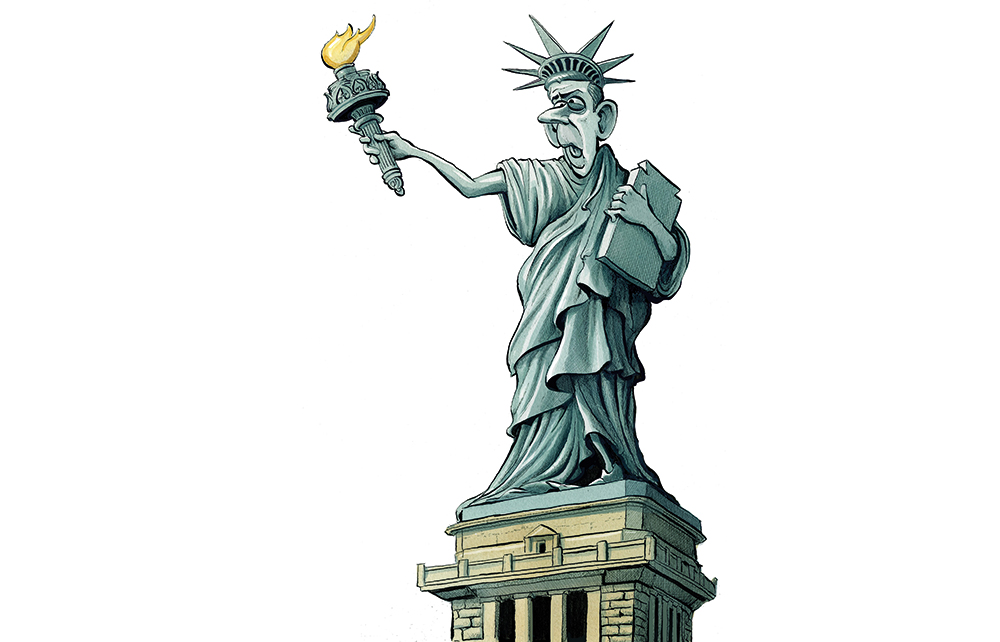It’s three years since the UK formally left the European Union and cut off free movement, and net migration has reached a record high: 606,000 in 2022. This total (measured by the number of new arrivals, minus people emigrating from the UK) is 118,000 higher than last year. This is certainly an increase from 2021, but nothing like the estimates that had been floated in recent weeks that suggested the net figure would be at least 700,000 – possibly even as high as one million.
The estimates originally came from a Centre for Policy Studies report, which calculated (based on visa approval statistics) a series of net migration scenarios. The assumption was that student visas were skyrocketing, as were the number of dependents they were bringing in: a ‘back door’ route to the UK labour market, as it was described by Home Secretary Suella Braverman.
The data today suggests otherwise: the percentage of non-EU immigration accounted for by students coming to the UK to study fell, from 47 per cent in 2021, down to 39 per cent in 2022. Meanwhile, those arriving by humanitarian routes – refugee schemes for Ukrainians, Afghans and Hongkongers – rose dramatically, rising from 9 per cent to 19 per cent of non-EU immigration over the same period.
Already much is being made of changes to the methodology for calculating the net migration figure, which has been updated to reflect earlier departures and a better understanding of the asylum data. But politicians have been sitting on the larger assumptions for weeks, giving them time to think about their response (which raises questions about what kind of modelling – if any – has been taking place inside government). And there has been near-universal agreement that this figure is too high.
Home Secretary Suella Braverman has been on a rampage against higher levels of net migration taking place under her watch, calling for net migration to fall to ‘tens of thousands’ — reminiscent of Theresa May’s goals back in the 2010s. Rishi Sunak has tried not to get too specific about his thoughts on legal migration policy (he is thought to have vetoed Braverman’s plan to raise the minimum salary threshold for skilled workers to come to the UK), but has put on record that the headline figure is too high. Such views are not confined to the Tory party. Keir Starmer went hard at PMQs yesterday lamenting the ‘quarter of a million work visas issued last year’, accusing the prime minister of having ‘lost control of immigration.’
But looking at the figures today, who do Sunak, Starmer and Braverman want to see leave?
It is almost certainly not the 172,000 refugees registered in 2022, up from 57,000 in 2021, and very unlikely to be repeated again – even the ONS’s update today notes the likely ‘temporary nature of these impacts’ – given the unique circumstances of last year. While the UK was a late adopter compared to the rest of Europe with its Ukrainian refugee scheme, ministers got there in the end and the country responded enthusiastically to letting Ukrainians in. This scheme, which has seen 168,700 people come to the UK so far, sits alongside schemes for Afghans and Hong Kong residents to find sanctuary in Britain — none of which politicians seem to have taken any public umbrage with.
It also seems unlikely that they want a serious crackdown on students, who in the last fiscal year boosted the UK economy by £41.9 billion. It remains up for debate whether students – who with their dependents were issued 627,000 visas over the year to March – should really be included in net migration figures, given that the majority leave the country when they are done studying (and under the new system, those that want to stay long-term need to find themselves a ‘high-skilled’ job).
There is even more evidence that students leave in the ONS update this morning, which states that students ‘typically stay for shorter periods than other migrants and that the majority leave at the end of their study,’ and finds that ‘those who arrived for study reasons in 2021 are now starting to leave, driving an increase in total emigration from 454,000 in 2021 to 557,000 in 2022.’ It seems that more students are coming to Britain, but they are leaving in bigger numbers post-study, too.
It’s telling that Braverman’s crackdown on student dependents this week was full of exceptions and loopholes, as to not put off too many students from coming to study in Britain. The plans make clear that the new rules are not meant to thwart the government’s International Education Strategy, which includes ‘meeting the target to host 600,000 international higher education students studying in the UK each year by 2030.’ Making it harder for dependents to come to the UK for students below the PhD level is estimated to reduce the number of migrants by up to 150,000 a year: this means the number of visas being issued (minus dependents) is actually too low for their strategy.
Who is left to show the door, then, but the Tier 2, high-skilled workers and workers on the occupational shortages lists: otherwise known as tax contributors and key workers? Go after these groups, and you can be fairly confident what kind of outcomes you’ll get: including a fall in tax revenue, longer wait times for key services like the NHS and social care, another surge in inflation due to an even tighter labour market, and a drop in economic growth. Health and social care visas are up 171 per cent last year; given the UK’s terrible shortage of doctors and social workers, it’s hard to see how that dramatic rise is anything but good news.
No doubt there are some people who would take that trade-off: being poorer with fewer migrants, you might decide, is better than being richer with higher levels of immigration. I have not yet, however, heard any prominent politicians say this out loud.
Others argue that you wouldn’t have to face such a trade-off if you prioritised the native workforce. Keir Starmer provided the perfect example yesterday, when he accused Sunak in the House of Commons yesterday of promoting a ‘low-wage Tory economy’ by bringing in people to work.
But to what extent is this really a battle between native and foreign workers? If the UK were suffering from an incredibly loose labour market – with no jobs on offer and people desperate to find work – this would be a far more relevant debate. But as things stand in the UK, there are still over one million job vacancies, not far off the record high reached during the pandemic. In other words, there are endless job options for anyone looking. And while inflation is eating into all of our pay-packets – taking its toll on real wages and making us feel worse-off – salaries are up roughly 6 per cent this year, with no evidence whatsoever that this record level of migration is holding them down.
Breaking down the types of immigrants that are coming to the UK in larger numbers shows why this is becoming a difficult area for politicians. Railing against the headline net migration figure – even one that’s come in significantly lower than expected – might be a politically popular thing to do, but it was much easier for them to point out who should stay or go when there was free movement and high levels of ‘low-skilled’ immigration taking place (I’d argue the merits in keeping pathways for low-skilled immigration: removing them seems to be contributing to a lot of the labour market problems we are experiencing now. But that argument was made and lost in the Brexit referendum).
But now ministers find themselves in an uncomfortable position of railing against a system that their party designed only a few years ago, which reshaped immigration policy to embrace the promise of ‘global Britain’ and attract more ‘high-skilled’ workers. Boris Johnson and Priti Patel’s reforms in January 2020 made good on the promise to end free movement and ‘crack down’ on certain types of immigration – so much so that most pathways for ‘low-skilled’ migrants to come to the UK were cut off. The minimum salary threshold was lowered, from over £33,000 to £26,500 – but this became the predominant way that a person could migrate to the UK long-term.
That’s what we’re now getting. The highest levels of immigration are no longer coming from EU countries, but India, Nigeria, Ukraine, and China. And the conditions under which they arrive to work are designed to make sure they are net-contributors, either through their taxes or through the critical work they are doing to keep services afloat.
If politicians want to insist today that this is a failure of public policy rather than a Brexit success story, they must start by saying who should go.







Comments